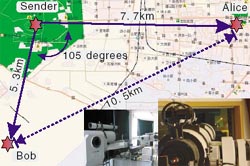

In today's Information Age, the protection of information is of critical importance for national security, business firms, and private individuals. The common long-distance communication technology is poor in keeping private as it is vulnerable to eavesdropping. Quantum cryptography, a new approach to communications based on certain phenomena of quantum physics, is considered the absolute secure method in this regard.
Recently CAS scientists have made progress in secure communication based on quantum cryptography. In their experiment, Pan Jianwei, Yang Tao, Peng Chengzhi and colleagues from CAS-affiliated University of Science and Technology of China (USTC) are successful in the free-space distribution of entangled photon pairs in a noisy city environment with a distance beyond the effective thickness of the aerosphere, marking a significant step towards the satellite-based global quantum communications.
Although so far some encouraging progresses have been achieved in the fiber-based quantum cryptography in recent years, the exponential loss of photon with the length of optical fibers leads to the maximum expected distance of effective communication limited to about 100km.
Fortunately, recent research shows a promising way to achieve the quantum communication for a longer distance or even an around the globe through satellite-based free-space distribution of entangled photons.
In the scheme, the photonic quantum states are first sent through the aerosphere, then reflected from one satellite to another, and finally transmitted back to the earth. Since the whole aerosphere is equivalent to 5-10 km ground atmosphere and in the outer space the photon loss and decoherence can be negligible, one can achieve global free-space quantum communication, with the help of satellites, as long as the quantum states can still survive after penetrating the aerosphere.
As reported in the April 22 issue of
Physical Review Letters, the CAS researchers demonstrate that the desired entanglement can still survive and be used in secure quantum communications after entangled photon pairs have been distributed through the noisy ground atmosphere of 13 km, which is longest yet and well beyond the effective thickness of the aerosphere.
Prof. Pan and colleagues started probing the issue of free-space quantum communication in 2003. In their experiment, the site for the source of entangled photons is located at the a TV tower at the Dashu Mountain with an elevation of 281meters in the western suburb of Hefei City, where entangled photon pairs were generated. Then the beam diameter was expanded by telescopes developed by the researchers and sent to two receivers located on the west campus of USTC and at the Taohua Town of the Feixi County of Hefei, respectively. At each receiver, a similar telescope is used to collect the entangled photons. The distances from the sender to the two receivers are 7.7 and 5.3 km, respectively, and photons from the sender to the receivers could experience a noisy city environment.
The environment at the sender site is wild and causes many difficulties, such as perennial strong winds, hot summer, air pollution and background lights, which could greatly affect the experiment. Prof. Pan and colleagues made tremendous efforts to overcome the difficulties and developed sets of telescope systems. Finally they confirm that the desired entanglement can still survive after both entangled photons have passed through the noisy ground atmosphere with a distance beyond the effective thickness of the aerosphere.
Although many entangled quantum pairs were scattered during the transmission between the sender and receivers, a fairly large amount of them still survived. The subsequent check-up by the highly-sensitive single-photon detector showed that the entanglement of pairs could still exist even if they are far apart, and both the quantity and quality of the information carried by the pairs could meet the requirement for the satellite-based global communication. Based on this, the research team succeeded in carrying out the quantum communication with absolute security by distribution of the entangled pairs. So far, the distance of 13km is the longest yet record ever made for effective prevention from eavesdropping.
Although compared to the previous experiments this experimental results might seem to be only a modest step forward, the researchers say, the implication is profound, presenting a significant step towards satellite-based global quantum communication. Other physicists in the field are impressed. "I congratulate the Chinese group on their success," applauds John Rarity, a researcher in quantum communications systems at the University of Bristol, UK. It shows space-based quantum key distribution is technically possible, he is quoted as saying.
The next target set for the research team is to increase the transmission distance to hundreds of kilometers, breaking out the limits for the optical fiber transmission.






